|
Introduction
When the net working storage capacity of a warehouse or distribution center surpasses the 85% utilization level, there is typically a concurrent reduction in warehouse productivity levels. This is caused by symptoms such as over-congested receiving and shipping docks, product being staged in operating aisles, commingling of multiple SKUs and/or pallets in storage locations causing extra work, etc. If this describes your operating environment, then it may be time to consider warehouse rack and aisle layout changes to increase storage capacity. In many cases, the lifespan of a warehouse can be extended by simply changing the type of storage systems in use. In this article, we describe several different options for racking systems and the considerations associated with each option.
We will begin with an overview of operating aisle widths and then shift gears into a discussion on the different type of high density racking systems that are available for conventional distribution facilities. This white paper does not cover high density storage systems that are available for automated distribution centers as that discussion is worthy of its own white paper.
Operating Aisles
Operating aisle widths are a function of: the type of mobile equipment being used; the size of pallets being handled; and the flexibility requirement for vehicles to pass within the aisles.
- Very narrow aisles (VNA) are typically in the range of 72" - 78” wide. They require the use of specialized turret trucks for pallet storage and handling; and/or order selector trucks for picking cases from vertical storage locations. Because the aisles are very narrow, only one vehicle can work in the aisle at any given time which imposes a constraint on how the facility operates. This operating environment is often deployed in buildings where the requirement for storage density is a very high priority; or when the variety of products being distributed exceeds the number of pick facings available at floor level. The use of turret trucks, order picking trucks or specialized very narrow aisle articulated forklift trucks is required for this type of system.
- Narrow aisles are typically in the range of 108" to 132". This operating environment is suitable for electric forklift trucks (e.g. stand-up, reach trucks). Aisle widths can be designed to allow two forklifts to comfortably pass within the aisle to support flexible operating requirements. Most facilities in North America are based on the use of narrow aisle operating systems.
- Wide aisles are typically 156" or higher. These facilities tend to use sit-down counterbalance lift trucks for heavy load handling or to enable a single vehicle to perform all unloading, storage, material movement and loading activities. These operations are common in full pallet environments such as in manufacturing or cross dock operations. Also, wide aisles are often deployed in conjunction with drive-in racking systems since the vehicle needs to be narrow enough to drive into the racking system and counterbalance forklift trucks lend themselves to this storage environment.
It is important to remember that moving from a wide aisle environment to a narrow aisle environment is relatively easy to do because it mainly involves the replacement of sit-down counterbalance trucks with electric reach trucks (or similar) and the re-installation of racks. The move from a narrow aisle environment to very narrow aisle is not nearly the same. A very narrow aisle environment imposes significant operating constraints onto a distribution center and there may be an adverse impact on productivity and throughput capacity if VNA is deployed in a building where flexibility requirements are high. This is why VNA warehouses tend to be the exception rather than the rule.
Rack Elevations are Important
First off, before considering changes to any existing racking systems, it is always worthwhile to conduct a quick survey to identify if opportunities are available to increase storage capacity by making changes to existing rack elevations. It may be possible to adjust horizontal beams within the racks as a means to increasing storage capacity. Start by walking the aisles to make a record of all existing rack elevations on the layout. You will also need to survey current pallet heights. A typical gap of 4 - 6" between the top of pallet and underside of beam is needed to enable forklift operators to store and retrieve pallets within a conventional racking system. Anything more than this is considered lost storage capacity which is where the opportunity for improvement may exist. When walking through the warehouse, if there is plenty of space above the pallets within their storage locations then this is a sign that new rack elevations may be worth looking into. A warehouse expert can advise you of the other considerations that come into play including overhead fire code clearance requirements, in-rack sprinkler implications, rack upright strength, forklift lift height constraints, etc.
If changing the racking system is required then multiple choices are available. Below is a list of several options available for high density storage.
Pallet Floor Storage and Block Stacking
This is essentially the storage of pallets on the floor such that there is no need for a racking system. Pallets are typically stacked 2 - 4 high on top of one another in designated storage lanes that are spaced on a center to center dimension based on the type of forklift truck in use. For example, a counterbalance vehicle that is 42" wide will be able to work in lanes that are 48" c/c if the pallets are stored on the 40" facing.
Block storage is a viable option for pallets that are capable of being stacked onto one another without causing any crushing or damage. Block storage is often used in buildings with a low a ceiling height (i.e. 21' or less) where storage density is maximized because there is no significant loss of vertical storage capacity. Of course block storage is free in the sense that fixed equipment need not be purchased which is a definite benefit. Block storage can also be used in warehouses where clamp trucks handle merchandise that is received on slipsheets instead of pallets.
Block storage is flexible in that it can be used for order picking full cases or it can be used for reserve pallet storage. The main issues that need to be considered are that inventory rotation is LIFO (Last in First Out) and that deep floor storage lanes are not generally well utilized due to the concept of honeycombing. Honeycombing refers to the loss of storage capacity that results because storage lanes always become partially full over time. The deeper the lane, the worse the true capacity utilization factor becomes. As well, if the quality of product packaging is poor then block storage can result in excessive product damage which we see quite often in warehouses that stock imported products produced in China and other countries in the Far East. The quality of corrugate tends to be reduced in environments that hive high humidity and this causes the boxes on the bottom-most pallets to be crushed by the weight of other pallets resting on top.
The main downside to block storage comes about if it is used extensively within a warehouse that has a much taller stacking height than the block storage requires. If the full vertical height of the building is not being used then there is a loss of storage capacity that may be worth recovering through the use of a pallet racking system.
Single Deep Selective Racking
Single deep racking is the most common racking storage system used in warehouses around the world. This is because this type of storage media offers total flexibility: 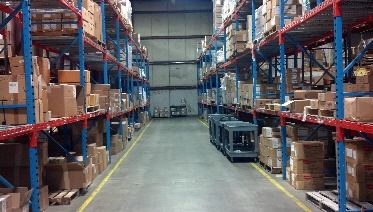
- Each storage location can be used to store a different SKU
- Multiple types of forklifts can be used to store and retrieve pallets
- Aisle widths can be very narrow, narrow or wide aisle depending on the type of mobile equipment being used.
- Suitable for full case picking and less than case picking environments
- Single deep post and beam racks provide the lowest cost per pallet position of any racking system option available.
- The storage and retrieval of pallets is fast and efficient
- Pallets can have varying shapes and sizes if wire mesh decks are deployed
- FIFO inventory rotation is supported
- When considering single deep racking, it is generally advised to obtain either safety bars or wire mesh decks for all vertical storage levels above floor level. This is to ensure safety in the event that a wooden pallet breaks or if product falls off of an overhead pallet. In addition, racks should always be bolted to the floor to prevent a rack collapse in the event of impact from a forklift truck.
The main downside to selective post and beam racks is that this type of system offers a low storage density relative to the other type of racking systems available to the market.
Double Deep Selective Racking
Double deep selective racks basically consist of two single deep racks positioned together (i.e. back to back) such that pallets are stored 2-deep instead of 1-deep. To access the second-deep pallet position in the rear of the rack, a specialized electric reach truck with a scissor-extension mast is required. When putting away to or retrieving pallets, the forklift operator does not have clear visibility of the second pallet position in the rear of the rack. This is why some forklift operators do not always like working with double deep racks as it does take some getting used to. Having said this, double deep racks are often used in warehouses where a combination of good storage density and operating flexibility is required. As well, double deep racking systems are commonly used for picking environments such that floor level positions are pick locations and vertical locations above floor level are used to store reserve inventory.
Double deep racks offer good storage density at a relatively low cost per pallet position. The main downside is that this storage media requires an investment into a new fleet of specialized electric deep-reach forklift vehicles. This may not be an issue for a greenfield site but it is a definite consideration when considering making changes to an existing facility.
A good video that visually explains how the double deep racking system works can be seen here.
Push-Back Racking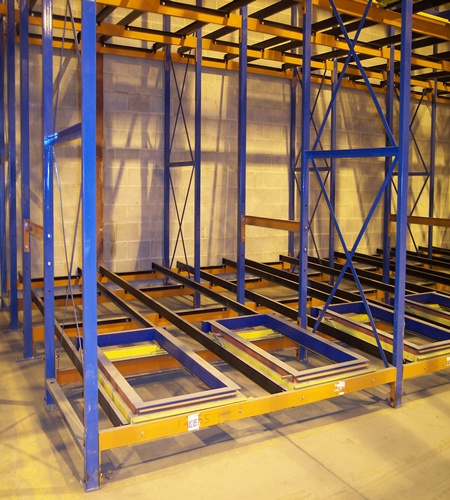
Push-back racks are specialized engineered racks that store between 2 and 6 pallets in depth. At the time of putaway, a pallet is pushed into a storage location (i.e. storage lane) such that pallets already stored in the lane are pushed backwards up a slight angled incline. At the time of retrieval, the lead pallet is pulled from the storage lane and gravity causes the unit loads behind the lead pallet to slide slowly forward to the front of the racking system. A nested system of rails is installed at the front of each storage lane to enable pallets to move backward and forward within the static racking system. Since the forklift truck always stays in the operating aisle, the driver is more productive than with a racking system that requires the vehicle to reach into or to enter the rack (see discussion on drive-in racks below). Push-back racks also offer excellent visibility because the operator is always working with pallets that face the operating aisle. This type of racking system is typically used for full pallet storage / retrieval and not for less than pallet order picking purposes but case picking can be done at floor level though it is recommended for a forklift truck to remove the empty pallet. In short, push-back racks offer excellent storage density and good forklift productivity for full pallet environments.
There are several downsides of push-back racks that need to be considered.
- These racks require a precise angle to ensure that pallets flow forward at a safe speed. This means that the horizontal beams are typically welded to the rack uprights such that there is no flexibility to change rack elevations down the road.
- Since pallets always enter and leave the racking system from the front of the rack, the inventory rotation within the storage lane is LIFO.
- Since pallets push against each other, it is generally recommended to use this type of storage system only for unit loads that are stable. Poorly palletized unit loads that have excessive overhang or are "leaning" may not make good candidates for push-back racking.
- The forklift truck must be capable of pushing pallets within an inclined storage lane when performing putaway. Not all forklift masts may be capable of handling this horizontal force so this needs to be verified, especially if the pallets being stored are excessively heavy and the system is 6-deep.
- There is a loss of vertical storage capacity resulting from the fact that pallets are stored on an angled rail system. This height loss becomes more pronounced as the system goes deeper. A bottom beam is also generally required. These factors contribute to a loss in usable storage height that will impact the available capacity within the racking system.
- Push-back racks are also relatively expensive as compared to conventional static racking systems.
A good video that visually explains how the double deep racking system works can be seen here.
Pallet Flow Through Racking
Pallet Flow Racks are racking systems that can store multiple pallets in depth such that FIFO inventory rotation is supported because pallets are always loaded from the rear and retrieved from the front of the racking system. These racks are specially engineered with angled rails such that pallets flow forward towards the front of the rack as soon as they are loaded into the rear of the storage rack assisted by entry guides. Each storage lane is equipped gravity-assisted rails with roller wheels to allow pallets to roll forward within the rack. The rails have drum brakes to create friction such that the pallets glide forward slowly and smoothly to the first open pallet position within the lane. A pallet stop at the front of the lane is used to stop the pallet from rolling out of the rack. This racking system can be used for full pallet storage and for full case order picking purposes.
There are downsides of flow through racks that need to be considered.
- These racks require an exact angle to ensure that pallets flow forward at a safe speed. This means that horizontal beams are typically welded to the racks and there is no flexibility to change rack elevations down the road.
- There is a significant loss of vertical storage capacity resulting from the fact that pallets are stored on an angled rail system. This height loss is more pronounced as the system goes deeper. A bottom beam is also generally required.
- Flow through racks are very expensive as compared to conventional static racking systems, drive-in racks and push-back racking systems.
A good video that visually explains the pallet flow through racking system can be seen here.
Drive-In Racking Systems
The drive-in rack is commonly deployed in storage environments where many pallets of the same SKU need to be stored together. Assuming a 40"w x 48"d pallet is being handled whereby pallets are handled on the short facing, the rack uprights are installed on the 51" center to center dimension. Drive-ins can be installed 2-deep up to 10+ deep. Pallets are loaded and also typically removed from the front of the rack system which means LIFO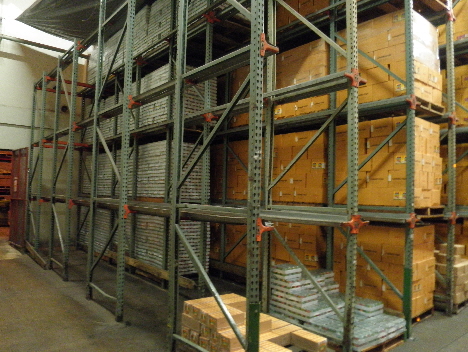 inventory rotation. inventory rotation.
With this type of racking system, the forklift drives into the rack to store and retrieve pallets. This implies using a vehicle that has a suitable outer width dimension that can fit between the uprights with adequate clearance on either side of the vehicle. The most common approach is the use of sit-down or stand-up counter-balance forklift with an overall width of 42" or less. Pallets are placed into the rack such that the outer edges of the pallets rest on an L-shaped rail bracket installed for the full depth of the racking system. This means that there are no horizontal beams used to support the entire width of the pallet. Therefore if pallets are not of a standard width or they are of inferior quality then drive-in racks are likely not a good option. If the pallet bows or bends due to the lack of continuous support (because the quality of the wood is inferior) then there is a good chance that the pallet boards will break and product will subsequently collapse within the rack which of course can be dangerous.
The cost per pallet for drive-in racks is generally more expensive than single/double deep racks but much less expensive than push-back or flow through racking systems.
There are downsides of drive-in racks that need to be considered.
- Drive-in racks are generally used to store a single SKU per rack bay only. If two SKUs are stored in a single rack bay then multiple pallet moves will be required to get at the right product which is highly unproductive.
- As mentioned early, this system requires a standardized pallet dimension and good quality
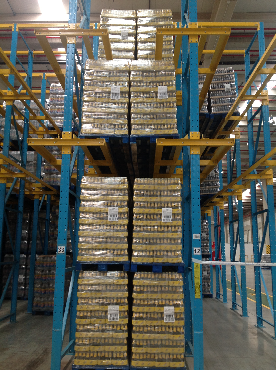 pallets. pallets.
- The net utilization rate of drive-in racks is usually 80% or less which means that only 80% or less of the gross pallet positions are ever used on average. This is known as honey-combing and is a by-product of the fact that only 1 SKU is being store in a rack bay that holds many pallet positions of storage. In general, the deeper the system the lower the net utilization rate.
- Higher than normal rack damage rates due to the fact that the forklift vehicle drives into the rack and the equipment clearances are generally very tight (e.g. 3" on either side of the vehicle).
A good video that visually explains the the drive-in racking system can be seen here.
For companies that need to improve productivity by moving pallets in pairs (e.g. the beverage industry) there is a company called Twinlode that has patented a double-wide drive-in racking system.
A good video that visually explains the the Twinlode drive-in racking system can be seen here.
Pallet Runner Shuttle Systems
The terminology "shuttle system" is often used in the industry to describe automated racking systems that have roaming shuttle carriers that may be independent or affixed to an automated and storage retrieval (ASRS) machine. We are not referring to automation systems in this instance.
A “pallet runner” shuttle system uses a mobile robotic shuttle carrier to transport pallets into available storage locations within a rack storage lane. The storage system can be as many pallet positions deep as needed since there is no constraint as far as this is concerned. The complete elimination of storage aisles provides the highest density of storage system available on the market. Pallets are loaded by forklift into one side of the racking system and removed from the opposite side of the system. FIFO rotation is therefore supported which is a big benefit for this type of storage solution. The most common environments for this type of solution are manufacturing plants that produce many pallets of the same SKU where space availability is constrained. These systems have also been deployed in freezers affixed to production plants (e.g. frozen bakeries) where the cost of space is at a premium and the SKU-count is relatively low.
The system is comprised of high density conventional static rack storage and robotic battery-powered shuttle carriers. The first step in the putaway process is for the forklift operator to place the robotic shuttle carrier into the racking system. To this end, the robotic carrier is lifted up and placed into the lead position of the storage level being accessed. Then the forklift takes a pallet of the SKU being stored and lifts it into the storage location and places it onto the shuttle carrier. The robotic shuttle carrier then drives on rails into the storage lane and deposits the pallet to the first available position within the storage lane. The carrier is equipped with sensors to detect the presence of other pallets in the lane. The carrier then returns to its starting point. Now the forklift can lift the next pallet of the same SKU up and into the location and onto the 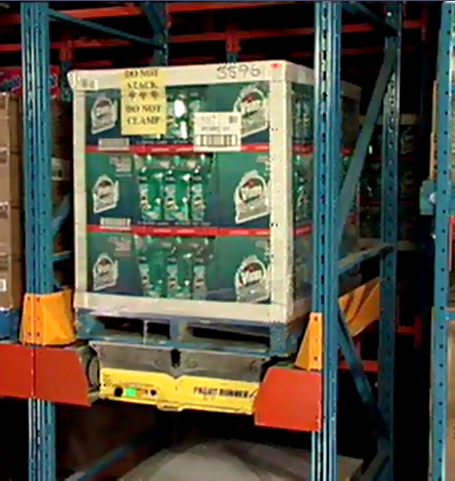 empty carrier. The process repeats itself until the batch of pallets for the SKU has been stored or the lane is filled. Once either situation arises, the shuttle carrier is removed by the forklift from the racking system. The extra effort to place the shuttle carrier into and out of the rack implies that this storage system is best suited to environments where batches of pallets for the same SKU need to be concurrently stored or retrieved. empty carrier. The process repeats itself until the batch of pallets for the SKU has been stored or the lane is filled. Once either situation arises, the shuttle carrier is removed by the forklift from the racking system. The extra effort to place the shuttle carrier into and out of the rack implies that this storage system is best suited to environments where batches of pallets for the same SKU need to be concurrently stored or retrieved.
At the time of pallet retrieval, a similar process unfolds. The forklift places the carrier into the lead pallet position of the opposite end of the storage lane to ensure FIFO inventory rotation. The shuttle carrier automatically drives into the lane to retrieve the first available pallet within the lane such that the pallet is transported to the first position facing the picking aisle. The forklift then removes the carrier with pallet from the racking system. During the week, a flushing process is typically performed during quiet times such that the robots shuttle pallets towards the front of the lanes to maximize system utilization and overall system efficiency.
There are downsides of pallet shuttle systems that need to be considered.
- There is a significant loss of vertical storage capacity. Each vertical storage lane requires a rail for the shuttle carrier to travel on, the shuttle vehicle itself needs to be lifted up and over a safety stop on either end of the system, and the shuttle itself needs to be placed into the storage location. It is not uncommon to require an additional 18" of height per storage level as a result. As well, a bottom beam is required with adequate clearance from floor level.
- The robots are battery powered and if the batteries do not last for an operating shift then spare robots are needed which increases the cost to the system since the robotic carriers are an expensive component of the overall system. As a result the system cost increases with throughput volume increases since more carriers are needed.
- Extra time is required to put the shuttle carriers into and out of each storage lane at the start of a putaway or retrieval task.
- The robots are in continuous use with forklifts and they are subject to damage as such. Since these vehicles are expensive, this needs to be a consideration when evaluating a system.
- If a pallet breaks within the middle of a storage lane, or similarly if product falls off of a pallet, then the only way to resolve the issue is to send a person into the lane to resolve the situation. An operator needs to be placed into a special cage that is shuttled into the lane so that the situation can be dealt with. Clearly this is not something that is for those of us with height sickness.
A good video that visually explains the pallet runner system can be seen here.
Flow Rail System
This is a relatively new entrant to the market so it is not widely deployed but nevertheless provides a very interesting high-density storage solution that can be deployed to retrofit existing post and beam or drive-in racking systems.
With this solution, 2 or 3 rails are installed for each pallet storage location for the full depth of the racking system. The box-shaped rails are approximately 4" wide x 4" high and their depth is equivalent to the depth of the rack system. The rails are bolted onto the horizontal beams of back to back single deep racks that can be built up to 10 pallets deep. Similarly, the rails can be installed to sit on the pallet rest-stops of existing drive in racks. Within the box-shaped rail is a patented chain that requires no maintenance or motors or gravity. The chain rotates clockwise and counterclockwise within the rail. As an operator stores the first pallet into a storage location, the first pallet is placed onto the lead position of the rails. The next pallet of the same SKU is stored by pushing the first pallet back to the second position in the storage lane. The forklift pushes the incoming pallet against the pallet already in the lane similar to a push-back rack except there is no uphill incline. The first pallet in the rack is resting on chains within the rails thus the horizontal pressure causes the chains to rotate in a clockwise direction in and the pallet flows back to the 2nd position while to incoming pallet is placed into the f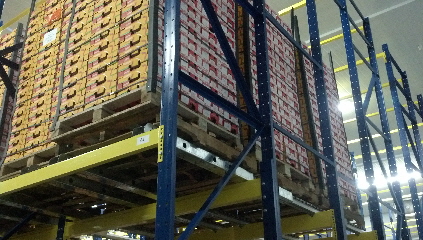 irst position. The process repeats itself until all pallet positions in a storage lane are consumed. irst position. The process repeats itself until all pallet positions in a storage lane are consumed.
The system is LIFO so pallets are always stored and retrieved from the front of the rack. For pallet retrieval, the forklift reaches in and tilts the first pallet up at the face of the pallet while leaving the rear of the pallet on the rail. The forklift then drives away from the rack causing the rails to rotate counterclockwise hence all pallets flow towards the operating aisle. Thus the system provides high density storage without the need for the vehicle to enter the rack. There is no use of angles, drive motors or robots so there is no loss of vertical storage capacity which is excellent. If drive-in racks are being converted with flow rails then the extra benefit is that each storage level can be used to store a different SKU due to the fact that the vehicle never needs to enter the drive-in rack. Flow-rail can also be used effectively to re-capture lost vertical storage capacity above operating aisles.
Of great interest is the forthcoming Spring-Rail Pallet Storage System whereby the chains are replaced with roller wheels and springs are used to bring the rear pallets forward rather than chains. This system will support 2,3 and 4-deep storage systems.
The downsides of this type of solution that need to be considered are:
- Pallets need to be a minimum weight of about 300 - 400 pounds to be handled in this type of storage environment
- Forklift operators must put and place pallets onto rails so the pallets need to be of a reasonable quality as there is no continuous support for the width of the pallet.
- There needs to be some type of system in place to let the operator know when pallet positions are no longer available within a storage lane because there is no visibility from the aisle of what is behind the first pallet within a storage lane
- The operator needs to approach the rack straight on so that the pallet is always resting straight on the chains hence this may imply wider operating aisles for environments where operators currently turn into racks.
A good video that visually explains the flow rail system can be seen here (loading) and here (unloading) and here (8-deep).
Early Supplier Involvement (ESI)
ESI is all about involving a qualified supplier up front in the design process. Some companies choose to work with racking suppliers to design their warehouse layouts which is appealing because racking suppliers may offer this service free of charge or at a low cost. Other companies choose system integrators where the integrator designs the system, sells and installs the equipment, and provides a turn-key service, Other companies choose to work with independent warehouse design / material handling consultants. These are important choices in and of themselves.
Because many racking suppliers and system integrators offer services in the design of rack and aisle layouts, it is possible to obtain advice on which system to choose for your distribution center. It is important to keep in mind that an equipment supplier or system integrator is in business to sell equipment so the solutions being proposed will only include the material handling systems that the supplier is capable of selling. One benefit of using an independent material handling consultant is that the consultant has no stake in the end-solution therefore the proposed solution will be the best one for your unique business needs. In other words, there is no predisposed bias that will cause the recommended solution to be anything other than the most cost-effective solution for your operation.
Lastly, there are many details involved in the specification of a racking system. Most importantly it needs to be engineered to handle the weight of the products being stored in the system. It makes no sense to cut corners and go for a low cost solution if the warehouse operators are exposed to any danger. Unfortunately too many companies do not pay enough attention to this basic statement and rack collapses cause tremendous injury, death and destruction. You need to click here to see what a rack collapse looks like.
Closing Statements
This white paper serves to point out that distribution center storage systems vary significantly and each option comes with its pros and cons. There is no such thing as a best system so it is important to be informed about why some systems work better in certain environments versus others that may not be as suitable.
Marc Wulfraat is the President of MWPVL International Inc. He can be reached at +(1) (514) 482-3572 Extension 100 or by clicking here. MWPVL International is an independent consulting firm that designs distribution centers and material handling systems. MWPVL International can help your firm evaluate the most appropriate storage solutions for your manufacturing or distribution operation.

|